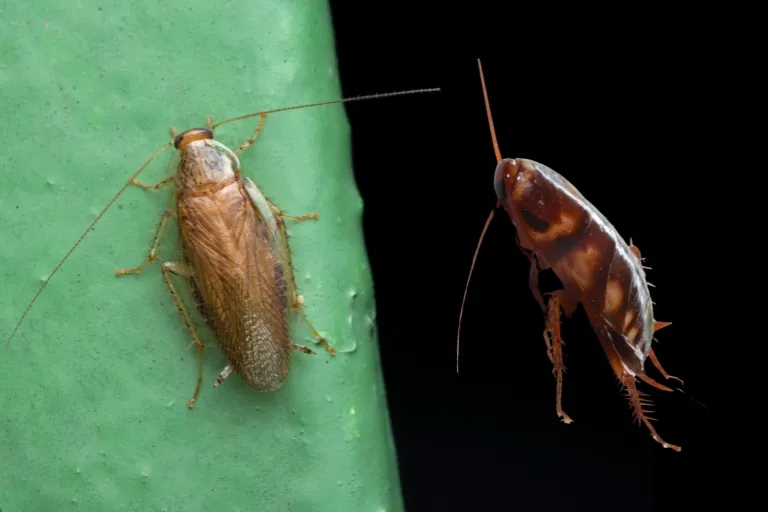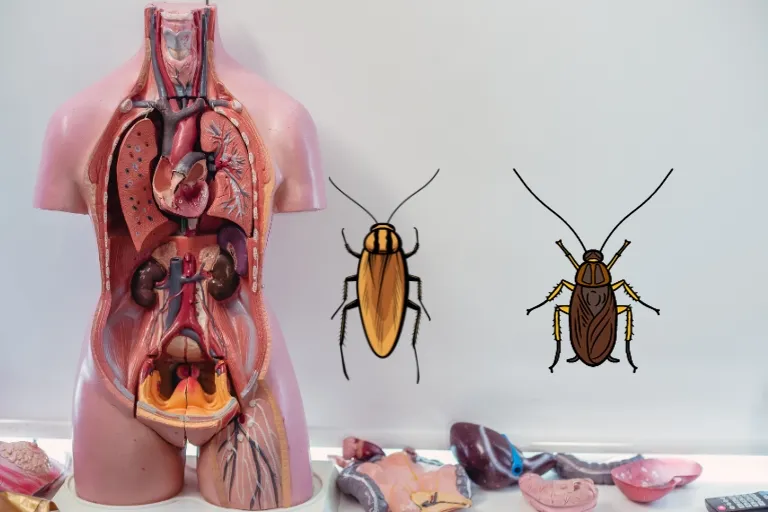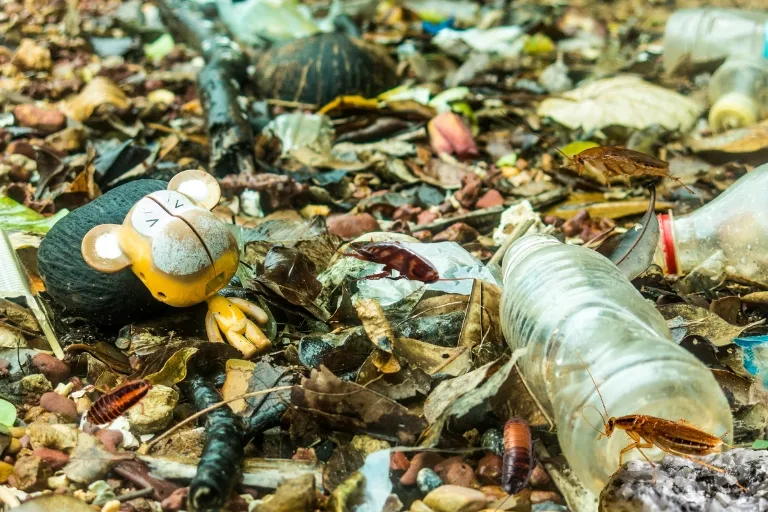German cockroaches are smaller and faster breeders, while palmetto bugs, also known as American cockroaches, are larger and more resilient. Both are common indoor pests, but they have different behaviors and habitats.
Understanding the differences between German cockroaches and palmetto bugs is crucial for effective pest control.
German cockroaches, often found in kitchens and bathrooms, thrive indoors and hide in small crevices. They reproduce quickly, making them a challenging infestation to control.
On the other hand, palmetto bugs prefer warm, moist environments and are often found in basements or around drains.
These pests can fly, and while they often venture indoors, they can survive outside as well.
Recognizing these pests’ distinct characteristics enables homeowners to take targeted action to prevent and eliminate infestations, ensuring a cleaner and healthier living environment.

Introduction To The Infamous Insects
The battle between humans and household pests is age-old, with two notorious characters often taking center stage: the German Cockroach and the Palmetto Bug.
These invaders are not only a nuisance but can also pose significant health risks.
Understanding the distinctions between them is key to effectively managing an infestation.
Here we will enlighten readers on how to recognize these pests and why it’s important to know your enemy.
Understanding The German Cockroach
The German Cockroach, Blattella germanica, is a small and resilient insect known for its rapid reproduction rate.
This species is particularly drawn to warm and humid environments such as kitchens and bathrooms.
Key Features:
- Color: Light brown to tan with two dark stripes behind the head
- Size: 13 to 16 mm in length when mature
- Wings: Possess wings but rarely fly
- Habitat: Indoor environments, often near food and water sources
Identifying The Palmetto Bug
Typically referred to as the Palmetto Bug, American Cockroach or simply the “water bug,” these insects are larger than their German counterparts.
They are commonly found both indoors and outdoors in warmer climates.
Notable Characteristics:
- Color: Reddish-brown with a yellowish hue on the back of the head
- Size: Up to 3 inches in length, making them one of the largest house-invading cockroaches
- Wings: Capable of flight, particularly in warm temperatures
- Habitat: Prefers moist environments but can thrive in a variety of settings
Importance Of Distinguishing Between The Two
Differentiating between the German Cockroach and the Palmetto Bug is crucial for effective pest control.
An incorrect identification can lead to the use of inappropriate treatment methods that may fail to address the infestation.
Targeted approaches are necessary, as each species responds differently to various control strategies.
Considerations for accurate identification include:
- Understanding the environmental preferences of each species
- Recognizing physical characteristics that set them apart
- Applying species-specific pest control techniques
Physical Characteristics: A Bug’s Anatomy
Delving into the world of insects, two species often mistaken for one another are the German cockroach and the palmetto bug.
While they may cross paths in your living space, these creatures are not the same.
By examining their physical characteristics, we can appreciate the subtle and overt distinctions that set them apart.
Let’s scrutinize the anatomy of these bugs, sizing up contrasting dimensions, spotting the visual differentiators, and uncovering the unseen distinctions that define their existence.
Size And Shape: Contrasting Dimensions
Understanding the disparity in size and shape between these insects is critical for identification.
Let’s compare their dimensions:
- German cockroach: Typically measures between 13 to 16 mm in length.
- Palmetto bug: Considerably larger, growing up to 4 cm in length.
| Bug Type | Length | Shape |
|---|---|---|
| German Cockroach | 13-16 mm | Oval and flat |
| Palmetto Bug | Up to 40 mm | Also has an oval body, but larger and more robust |
Color And Markings: Visual Differentiators
Color patterns and markings provide visual clues that are vital for telling these two species apart.
Let’s highlight those differences:
- German cockroach: Exhibits a light brown color with two dark, almost parallel stripes running from its head to the base of its wings.
- Palmetto bug: Boasts a darker reddish-brown hue with a smoother, more uniform appearance.
Anatomical Details: Unseen Distinctions
There’s more to these bugs than meets the eye. Let’s explore the anatomical intricacies that elude the average observer:
- Antennae: The German cockroach’s antennae are longer relative to its body size, enhancing its ability to detect food and predators.
- Wings: While both species have wings, the German cockroach rarely flies, unlike the palmetto bug, which is known for its flight capabilities.
- Reproductive parts: A close inspection would reveal differences in the reproductive anatomy that influence their breeding behaviors.
Habitats And Behaviors: Survival Strategies
The German cockroach and the palmetto bug are two commonly encountered pest species, each with unique survival strategies that have enabled them to thrive in various environments.
Understanding their distinct preferred habitats, feeding habits, and reproductive cycles is crucial for effective pest control measures.
Preferred Environments: Where They Thrive
German cockroaches are notorious for their love of warm and humid environments.
They often find residences inside homes, restaurants, and food processing facilities.
Their stealth and adaptability have made them unwelcome inhabitants in human dwellings.
On the other hand, palmetto bugs, often referred to as American cockroaches, have a preference for damp and dark areas.
They are primarily found in basements, sewers, and woodpiles, venturing indoors in search of food and water.
Feeding Habits: What’s On Their Menu
- The German cockroach has an omnivorous diet and is particularly attracted to starchy and sugary foods, making kitchen areas a hotspot for these pests.
- Palmetto bugs are also not picky eaters and will consume a wide range of organic matter. Their menu often includes decaying matter, but they can also feed on hair, skin, and book bindings.
Reproduction And Lifespan: Proliferation Of Pests
German cockroaches are prolific breeders, with a single female capable of producing thousands of offspring in her lifetime.
Their rapid reproduction cycle and resilience make them challenging to eradicate. Palmetto bugs have a longer lifespan but breed less frequently.
However, they can still sustain their populations for longer periods, which poses a persistent problem for residents and business owners.
| Species | Reproduction Rate | Lifespan |
|---|---|---|
| German Cockroach | High | 6-12 months |
| Palmetto Bug (American Cockroach) | Moderate | Up to 2 years |
Both pests have tailored their survival strategies to their environments and sources of nourishment.
While the German cockroach is smaller and can hide more easily in nooks and crannies, palmetto bugs tend to be larger and can use their size to survive in harsher conditions.
Human Interaction And Impact
Engaging in the perpetual battle with household pests, we often find ourselves facing two notorious invaders: the German Cockroach and the Palmetto Bug.
While both may incite fear and disgust, understanding their specific impact on human health and property is crucial.
These creatures not only affect our quality of life but also pose significant challenges that demand attention and action.

Health Risks And Allergens: Public Health Concerns
Both German Cockroaches and Palmetto Bugs pose a risk to human health, mainly through the spread of bacteria and potential allergens.
Regular encounters with these pests can result in aggravating asthma symptoms and triggering allergic reactions in sensitive individuals.
- German Cockroaches are infamous for spreading diseases such as Salmonella, E. coli, and other bacteria by contaminating food surfaces.
- Palmetto Bugs can carry pathogens on their bodies as they travel through decaying matter and sewage before entering our homes.
In households with these pests, allergy and asthma flare-ups often become more frequent, highlighting the importance of prompt and effective pest control measures.
Property Damage And Infestations: The Economic Toll
Infestations can lead to significant property damage, as these insects are not just unsightly but also destructive.
The German Cockroach, for example, has a voracious appetite and can chew through materials like paper, packaging, and even some textiles.
On the other hand, Palmetto Bugs, although less likely to cause physical damage, contribute to an unhygienic environment.
Frequent sightings of these pests can diminish property value and have potential implications for hospitality-related businesses, resulting in a tangible economic impact.
Cockroach Control And Extermination Measures
Effective control and extermination of these pests require a multi-faceted approach.
Here is a step-by-step guide to keeping your home or business free from German Cockroaches and Palmetto Bugs:
- Inspection: Identify potential entry points and nesting areas within the premises.
- Sanitation: Eliminate food and water sources that attract these pests by maintaining clean spaces and properly storing food.
- Exclusion: Seal cracks and crevices to prevent entry and reduce hiding places.
- Chemical Control: Use baits, residuals, and insect growth regulators as part of an integrated pest management approach.
- Professional Help: In cases of severe infestation, contacting a licensed pest management professional is often the most effective solution.
By systematically addressing the issue, the incidence of pests can be significantly reduced, thereby protecting public health and avoiding economic losses.
Prevention And Management: Avoiding Pest Problems
The battle against unwelcome household pests like the German cockroach and the palmetto bug starts with prevention and management.
Implementing effective strategies is crucial to avoid infestations before they become major issues.
Integrating sanitation and maintenance practices, seeking professional pest control solutions, and considering the merits of natural remedies versus chemical approaches can make all the difference in maintaining a pest-free home.
Sanitation And Maintenance Practices
Keeping pests at bay begins with strict sanitation and maintenance. Both the German cockroach and palmetto bug thrive in dirty, cluttered environments.
To disrupt their habitat:
- Regularly dispose of trash in sealed containers.
- Clean spills and crumbs promptly to avoid attracting pests.
- Store food in airtight containers to eliminate food sources.
- Fix leaks and eliminate standing water to reduce moisture.
- Declutter your space to remove potential hiding spots.
Regular home maintenance also prevents pest entry. Seal cracks and crevices, install door sweeps, and manage exterior vegetation to create a barrier against these insects.
Professional Pest Control Solutions
When infestations escalate, professional pest control solutions might be necessary.
Pest management professionals (PMPs) can provide:
- Thorough property inspections to identify infestation hotspots.
- Customized treatment plans targeting specific pest pressures.
- Follow-up visits to ensure the effectiveness of control measures.
PMPs use a variety of tools and techniques that offer swift and effective results.
Their experience allows them to tackle large infestations safely and sustainably.
Natural Remedies Vs. Chemical Approaches
Homeowners often weigh natural remedies against chemical approaches for pest management.
Natural options can include:
- Using essential oils (like peppermint or neem oil) can deter pests.
- Diatomaceous earth is a powder that damages the exoskeletons of insects.
- Boric acid is a less toxic chemical that disrupts the pest’s digestive system.
Chemical insecticides offer a more aggressive solution and may provide quicker results.
Yet, these should be used judiciously due to their potential impact on the environment and non-target species.
Balancing the two approaches depends on the severity of the infestation, the presence of sensitive individuals (like children or pets), and personal preferences for eco-friendly solutions.
Cultural And Environmental Considerations

When considering the impact of insects like the German cockroach and the palmetto bug, it’s crucial to explore both the cultural perceptions these creatures evoke and the environmental roles they play.
These ubiquitous pests not only trigger reactions ranging from disgust to fear but also serve vital functions within their ecosystems.
How society perceives them and the ecological balance they help maintain are both significant factors shaped by and reflected in our cultures.
Understanding these elements is key to managing human-insect interactions effectively.
Pests In Popular Media: How They Shape Our View
The German cockroach and the palmetto bug have both been immortalized in popular media, casting a long, often negative shadow over their reputations.
Characters in horror films, television shows, and literature frequently depict these insects as harbingers of dirt and disease, instilling a deep-seated aversion in audiences worldwide.
Such portrayals influence cultural attitudes, leading to a widespread lack of understanding about the real nature of these creatures.
Ecological Roles: Understanding Ecosystem Impact
Despite their unsavory reputation, both the German cockroach and the palmetto bug serve critical functions in their natural habitats.
As scavengers, they aid in decomposing organic material and recycling nutrients back into the soil.
They also form a substantial part of the food web, providing sustenance for a variety of predators.
Acknowledging their ecological roles helps to rebalance the narrative and fosters an appreciation for these oft-maligned insects.
Future Prospects: Adjusting To A Changing Climate
Climate change poses new challenges for both pest control and the survival of species like the German cockroach and the palmetto bug.
Rising temperatures can lead to expanded habitats and longer breeding cycles, possibly increasing their prevalence.
Concurrently, environmental stresses could provoke adaptational responses, altering their roles within ecosystems.
Proactive research and adaptive management strategies are essential for maintaining the delicate balance between human environments and the health of our planet’s ecosystems.
FAQs On German Cockroach Vs Palmetto Bug
Are Palmetto Bugs The Same As German Roaches?
Palmetto bugs and German roaches are not the same. Palmetto bugs are larger and primarily found outdoors, while German roaches are smaller and commonly infest indoor spaces.
How To Tell The Difference Between A Cockroach And A Palmetto Bug?
To differentiate a cockroach from a palmetto bug, recognize that “palmetto bug” is a term often used for American cockroaches. They are the same insect; differences lie in regional naming preferences, not species. Analyze the context of the name used to distinguish.
What Is The Hardest Cockroach To Get Rid Of?
The German cockroach is known to be the hardest to eliminate due to its rapid reproduction and adaptability to various poisons.
Why Do People Call Roaches Palmetto Bugs?
People call roaches “palmetto bugs” because they often hide under palmetto leaves in warm climates, and the name sounds less alarming than “cockroach. “
Final Thoughts
Understanding the differences between German cockroaches and palmetto bugs is crucial for effective pest control.
Each species has unique behaviors and requires specialized approaches to management.
Remember, identifying your adversary is the first step in any battle against household pests.
Stay informed, take preventive measures, and consult professionals if necessary, to keep your home insect-free and healthy.
Resources:
1. https://kids.niehs.nih.gov/topics/natural-world/wildlife/insects/cockroaches
2. https://lancaster.unl.edu/pest/resources/cockroachmanagement.shtml
